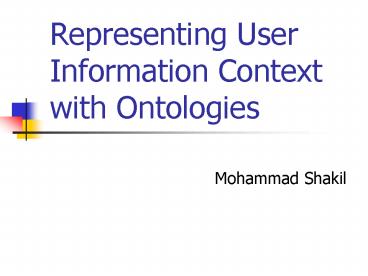Representing User Information Context with Ontologies - PowerPoint PPT Presentation
1 / 17
Title:
Representing User Information Context with Ontologies
Description:
Consider word 'Python' - Web search engine retrieves all pages containing word Python - Python as a snake, a programming language or a type of the music ... – PowerPoint PPT presentation
Number of Views:89
Avg rating:3.0/5.0
Title: Representing User Information Context with Ontologies
1
Representing User Information Context with
Ontologies
- Mohammad Shakil
2
INDEX
- Introduction
- Representing and Maintaining User Context
- Maintaining User Profiles
- Utilizing User Context for Web Search
- Conclusion and Outlook
3
Introduction
- What you need to build Users Information Context
- Semantic knowledge about domain being
investigated
- Information expressed in query
- User Profiles
- Paper proposes the Framework which captures
users - context via nodes in a concept lattice
induced from original Ontology and it is updated
based on the users interaction
4
Problem Consider word Python -gt Web search
engine retrieves all pages containing word
Python -gt Python as a snake, a programming
language or a type of the music -gt System does
not have a knowledge about who is asking for
information and for what
purpose so it gives general answers -gt One size
fits all absence of user preference, search
context or task context
5
Solution
- Contextual Retrieval
- Combine search technologies and knowledge
about query and user context into a single
framework in order to provide the most
appropriate answer for a users information needs
6
How to integrate the essential elements of the
users context?
- Imagine a system where user interacts with a
domain-specific ontology, represented as a
concept hierarchy - Disambiguate the user context using domain
knowledge inherent in the ontology - Represent context as an extension of concept
hierarchy and maintained and updated overtime for
user profiling - Use the context developed above in future for
different information access activity
7
Example
8
Representing User Context
- Domain Ontology Key Concept
- What is Ontology?
- is-a relationship between set of
- concepts thus Organized as a concept
- taxonomy
- Term vector Representation
- Use of documents indexed under concepts
- Compute a weighted term vector for each concept
along with sub concepts - Thus aggregation of term vector provides a
natural partial order among concepts in the
ontology
9
How the User profile is built?
- User interacts with the presented ontological
output by selecting and deselecting nodes - Selection is called Positive evidence
- Deselecting is called Negative evidence
- Profiling attempts to learn user behaviour
through users browsing and searching - Use of Concept Lattice
10
Concept Lattice
- User context is represented as a pair of
elements ltP,Ngt - When multiple operations are selected then
positive aggregation is done through min
operation and negative evidence is done through
max operation - Max Greatest Lower bound meaning intersection
of all vectors presenting in query - Min Least upper bound meaning union of all
remaining vectors - Example. If user give two words in a query then
through the pages retrieved by these includes
Positive Evidence which includes only those terms
appearing at both the place
11
Issues in Maintaining Users Profile
- Once the profile is created it should be
maintained and updated, a new context should be
added if necessary - How this is going to help?
- User Profiles are utilized to provide the
user with a domain ontology that is more
consistent with their view of the world - But this should not be done every time
12
Solution to Updating of User Context
- Build short term context every time for PE and NE
- Compare it to the users long term information
context - If similarity between two term vectors exceeds a
certain threshold then profile should be updated - Another option is associate each context in user
profile with specific ontology so user can switch
between representation of different domain
ontologies
13
Utilizing User Context for Web Search
- Now it is time to look at how we will use the
user context to enhance users initial query. - ARCH (Adaptive Retrieval based on Concept
Hierarchies) Web Agent - Processing of a query
- example Python
14
(No Transcript)
15
Just to Refresh 585
- RECALL is the ratio of the number of relevant
records retrieved to the total number of relevant
records in the database. It is usually expressed
as a percentage. - PRECISION is the ratio of the number of relevant
records retrieved to the total number of
irrelevant and relevant records retrieved. It is
usually expressed as a percentage.
16
Analysis
17
Conclusion
- We discussed framework for Contextual information
access using ontologies - Use of long term user profile
- Method of capturing users context via nodes in
concept lattice and updating the user context
upon users interaction - Thus this can definitely improve effectiveness of
the search queries - Future work involves modeling the framework to
include long term vector representation and
defining object oriented representation of term
vector so that relationship between different
concepts can be established according to their
properties.































